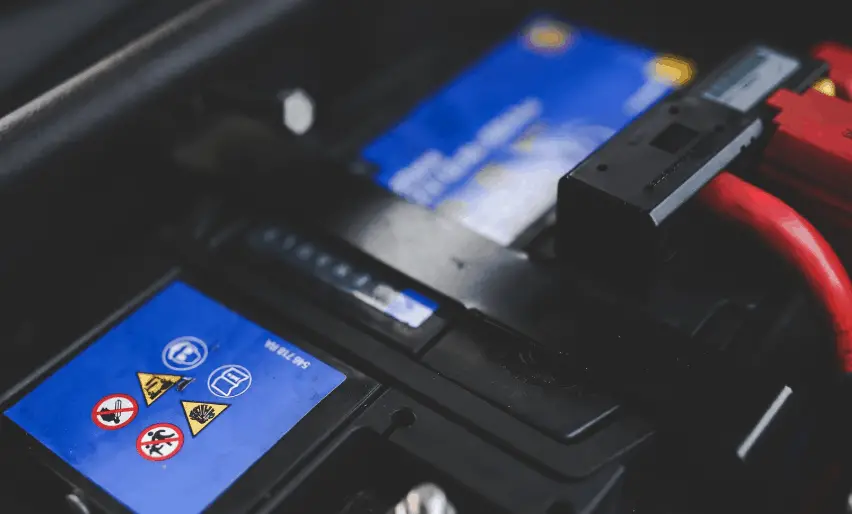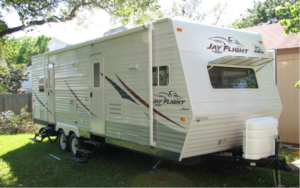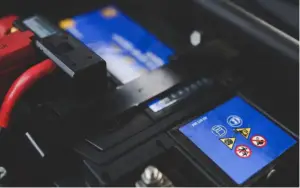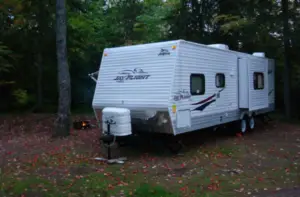When you are planning to hit the road with your RV, the last thing you would want is a poorly functioning battery or a sudden power loss.
RV travels don’t often involve easy access to new batteries or power sources, and there are times when you may witness that your RV battery is draining faster than you expect it to.
And that’s why, it’s a must to be aware of the different factors that may be damaging the battery or consuming its power quickly.
Scroll down to get your hands on the different possible reasons that drain an RV battery at a higher rate than the normal, while also learning what all you can do to prevent the same and extend the overall life span of the battery.
Reasons Why an RV Battery May Drain Faster than Expected
Lets now discuss the chief factors that may drain the battery of your RV much faster than expected, along with what causes them as well as how they affect the performance of the battery.
RV Battery can drain faster than expected due to :
Parasitic Loads
Parasitic loads is a term for the different appliances or systems in your recreational vehicle that keep drawing power from the battery when not needed or not in use.
Once you turn off the engine, the alternator stops running, and anything that still draws power is going to extract it from the RV battery.
Parasitic loads can not only shorten the lifespan of the battery, but also drain its charge, make recharging it quite difficult, and lead to sulfation.
Sulfation
The accumulation of lead sulfate crystals on the battery is a major reason behind fast draining batteries.
Sulfation occurs when a battery isn’t allowed to charge fully and can further hamper the conversion of chemical energy into electrical energy within the battery.
Sulfation can also happen due to overcharging, storing the battery at extremely high temperatures, or storing it with an empty charge.
It can lead to buildup of excess heat, reduced battery life, complete failure, shorter running duration, or make the battery take much longer to charge.
Sulfation can be permanent or reversible. If caught on time, it can be fixed but nothing can be done except for replacing the battery if the sulfation is permanent.
Self-Discharging
One of the most common issues with batteries is self-discharging, which is not really a defect but a definite phenomenon with all batteries.
However, wrong battery handling can increase self-discharging, further leading to irreversible effects.
Other factors that increase a battery’s self-discharge include high temperatures, cycling and battery age. Lead-acid batteries used in RVs often come with 5% monthly self-discharge rate, which is one of the lowest out there.
But as the battery gets old, sludge builds up in the battery’s sediment trap and can lead to shorts within the battery’s casing. This in turn, increases self-discharging of the battery, and you may find it draining quite fast.
Undercharging
Undercharging the battery plays a key role in shortening its lifespan and depletes active material inside the battery.
This happens when the user doesn’t allow the battery to return to full charge after using it, which may lead to sulfation quickly.
Complete battery failure, shorter performance duration, as well as the formation of sulfate on the cell plates are some common problems caused by undercharging.
Overcharging
Overcharging can happen because of using the wrong charger, or not installing an efficient alternator to regulate the charge.
Leaving the charger on for too long or using incorrect charging voltage can overcharge your RV battery.
This can further lead to complete battery failure, increased water consumption by the battery, as well as corrosion of battery plates.
It can also cause overheating of the battery by raising the temperature of the distilled water and sulfuric acid solution.
In that case, the battery will not only swell or bulge, but can also feel super hot to touch or even start melting.
Gas seepage may also occur due to the buildup of flammable hydrogen inside the sealed cells of the battery, which can further lead to explosions.
Lack of Maintenance
Lack of maintenance and an improper charging can also kill your RV battery. Not adding enough water may prevent the battery from charging fully, while charging a frozen battery can lead to an explosion.
Out-gassing or explosions can also happen when you fast charge maintenance-free batteries.
Not fixing the sulfation on lead-acid batteries makes them incapable of storing power, so it’s essential to run it on “battery maintenance mode” for a few minutes to break up the sulfate buildup on the plates occasionally.
What to Do to Keep the RV Battery in Better Condition
You can always take a few measures and practice the right maintenance steps to keep your RV battery in better condition.
Recharge The Battery on Time
Undertaking regular maintenance and recharging the battery in time extends its life. Always charge it up to its fully saturated charge to prevent sulfation when you are putting the battery away.
Plus, don’t allow the battery to remain discharged or below 12V as it can ruin it permanently over time. Let it charge fully in a well-ventilated area for around 14 to 16 hours.
Avoid Deep Discharges
Deep discharges reduce the life of a battery, and that’s why you must avoid them. If using the RV battery for heavy load, charging it in short breaks of 1- 2 hours increases its lifespan.
A brand new lead-acid, deep-cycle battery can be charged only up to 70% capacity. Formatting the battery by using it at the specified capacity for gentle use or loads for its initial five charge cycles also improves its life.
Use a Digital Multimeter for Maintaining Optimal Charge
It’s a good idea to use a digital multimeter to check if your battery is overcharged by connecting the device to the terminals while the vehicle is running at idle.
The right charge should be around 12.6 volts, which is fully charged at 2.1 volts for each internal cell. The volts will increase to an average of 14 volts when you turn on the radio, lights or the air conditioner.
If the battery registers more volts than that, it means its overcharging. Check the alternator or apply a trickle charge by low amp settings if using a battery charger. It’s best to charge the battery after it has used half of its capacity.
Maintain the Electrolyte Above the Top of the Plates
Make sure the electrolyte never drops below the top of the plates as exposing the plates may make them inactive. If you see that the electrolyte is low, simply cover the plates with enough distilled water before charging.
Once fully charged, fill the water to the right levels marked by a fill line. Make sure you never add acid to avoid raising the gravity level too much which may lead to excessive corrosion.
Always use de-ionized water or distilled water for your RV batteries. If you have to use tap water, make sure to check it first before using it as tap water is not usable everywhere.
Eliminate Parasitic Loads
Those modern amenities inside your RV may be draining the batteries too fast when you turn off the RV.
Test the battery using a digital multimeter to check if its suffering from parasitic loads, including microwaves, refrigerators, televisions, lights, cell phone charging systems, GPS systems and more.
Once you turn off the ignition of your RV, connect the multimeter to the battery, and you will know if something is draining it quickly.
Next, you need to find out the specific appliance that’s draining it by pulling out the fuses of different machines.
You won’t be able to get rid of all parasitic loads, but you can surely eliminate the bigger ones.
Use Anti-Sulfation Devices
You can prevent or fix sulfation by using anti-sulfation devices that apply pulses to the terminals of a battery.
However, this is only helpful when you take appropriate measures to maintain the battery and lessen the buildup of sulfates.
What’s the Average Life of an RV Battery
Typically, an RV battery lasts around 5 to 7 years. However, the exact lifespan of the battery may vary with the frequency of use, the type of battery you install in your vehicle, as well as how you maintain it.
While deep-cycle RV batteries last for around 500 charge cycles, efficient lithium-ion battery can work for up to 5,000 charge cycles or more.
How to Store Your RV Battery When Not in Use
It’s essential to store your RV batteries the right way otherwise it may end up in ruining the batteries when not in use.
First of all, make sure not to drain the batteries before storing them for the off-season. Most RVs have 12-volt loads like circuit boards, stereo clocks, and gas detectors that gradually drain the battery, which is not good for the batteries while in storage and may discharge it completely.
Having the batteries drained below 50% of their capacity shortens their life span, and can also lead to the freezing of the fluids in discharged batteries.
Once, you make sure that the battery is fully charged to allow it to withstand extreme temperatures, keep parasitic loads from draining them by using a battery kill switch.
Park your vehicle in a climate-controlled space, further removing the RV batteries and putting them in the garage.
It’s totally alright to keep 12-volt lead-acid RV batteries on concrete floor if the garage is not below freezing temperatures.
Whether you are removing the batteries for off-season storage or let them be in your RV, make sure they are clean with their cells filled with distilled water to optimal levels.
Other Preventive Things to Do
While maintaining the battery is surely crucial to making it last long, below are some preventive things to do that work wonders when it comes to reducing the load on your RV battery.
Use Chassis Batteries for Charging Small Devices
It’s recommended to use a 12-volt USB port deriving power from the chassis batteries when you are charging watches, cellphones, tablets, cameras, or laptops.
If possible, avoid turning on the inverter for charging small devices as the inverter coverts the power of the battery from DC to AC to power itself first, further running that power to different outlets in the vehicle.
This drains a significant amount of power on your RV battery. On the other hand, it leads to a negligible power drain from the chassis batteries for charging those devices.
Prefer Using a Generator For Heavy Consumers Temporarily
If you need to use a microwave, a griddle, or electric frying pans frequently, then it’s a good idea to power them using a generator instead of the battery.
Using these appliances for a deal of even 30 minutes can drain the battery of your RV quickly. And that’s why, it’s recommended to bring a generator along if you are traveling for longer duration.
Keep Your RV Battery Protected from Extreme Temperatures
Below freezing temperatures or extremely high temperatures are likely to shorten the lifespan of the battery or damage it completely.
Very high temperatures can even reduce the capacity of the battery by 50%, thereby making it work harder and eventually damage it.
Extreme temperatures can also lead to the blowing up or bulging of the battery, while freezing weather conditions reduce the charge cycles by draining the RV batteries much faster.
Excess cold can also make some lithium-ion batteries to stop charging, and that’s why it’s crucial to place the battery away from excessive cold or heat.
Install a Portable Refrigerator
The kind of refrigerator you install in your RV may also help in extending the life of the battery. An 8-cubic feet refrigerator takes around 600 watts when running for the entire day, which is surely a lot of power.
You can reduce this consumption by installing a portable refrigerator as it comes with inbuilt batteries and doesn’t depend on the RV battery.
How to Tell if RV Battery is Bad
If your RV battery is not able hold charge for long or is demonstrating an erratic performance, there are chances that it’s damaged or going bad.
You must identify a damaged battery to avoid facing troubles while you are on the go. To avoid the same, you need to inspect the battery for any signs of the battery going bad.
A few major signs of a damaged battery include :
- Broken terminals
- Discoloration
- Bulges or bumps in the casing
- Leakage
- Cracked or ruptured casing
Loose or broken terminals are quite dangerous and using the battery can lead to short-circuits or even a sudden explosion of the battery, thereby causing accidents or injuries.
If the RV battery shows a bump or bulge, it’s a sign of an overcharged battery and you must replace the same.
While holes, splits and cracks may not lead to any problems with the battery’s performance, it’s not safe to use a cracked battery and it’s a good idea to replace it as soon as possible.
While you can check for physical damages in the case of flooded batteries to determine that it’s damaged, you cannot do the same for a gel battery or a sealed AGM battery.
You need to go for measuring the voltage for such batteries. You need to perform load testing on a charged battery – if it takes no more than 30 seconds for the voltage to drop down or it quickly reaches 0 V, then you can be sure that the battery is bad.
Conclusion
Taking a look at the aforesaid reasons that lead to an abnormal power consumption of an RV battery, as well as the tips to avoid the same – it can be rightly concluded that all it takes is a few preventing steps to maintain the battery.
Perform timely inspections of the battery to check for any external damages, bulges or leakages, while making sure you store it in favorable temperature conditions when not in use.
Apart from that, avoid over-charging or undercharging the battery, accompanied by avoiding sulfation and minimizing parasitic loads that may drain it faster.
While all batteries come with a specific lifespan and need to be replaced some day, you can always prevent untimely damages and drains with just a bit caution.





